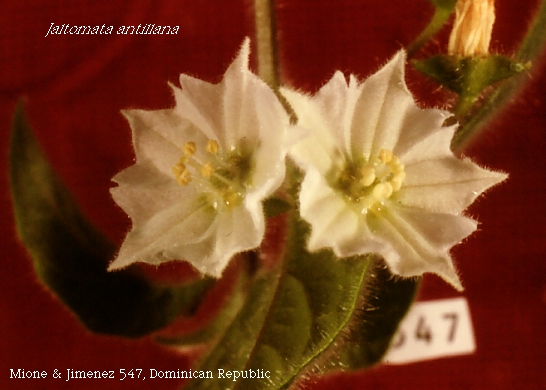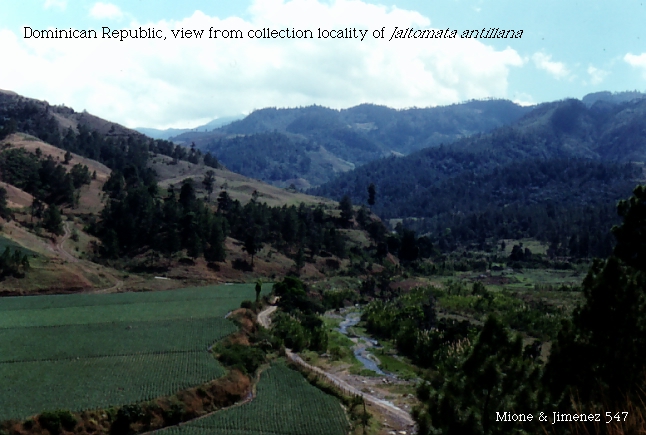Above: Photo by Karena Kulakowski with prof T. Mione taken in greenhouse, in Connecticut;
plant grown for study from seed collected in Dominican Republic.
Photo by Ciara Kilkenny with prof T. Mione, accession Mione & Jimenez 547.
Jaltomata antillana (Krug & Urban) D'Arcy |
Greater Antilles |
revised Sept 2023 |
Link to Jaltomata homepage |
The information on this page may be cited as a communication with professor Thomas Mione, Central Connecticut State University, Biology Department, Copernicus Hall, 1615 Stanley Street, New Britain, CT 06050-4010 USA |
Annals of the Missouri Botanical Garden 65:
780. 1978. |
| Figure 1. Flower of Jaltomata antillana. Diagnostic Features of this species: viscous-gland-tipped hairs of two
length classes, white rotate corolla to 2.5 cm in diameter,
pubescent/villous filaments, fruits bright red. The only Jaltomata of the Greater Antilles. Mione
& Jimenez 547. Above: Photo by Karena Kulakowski with prof T. Mione taken in greenhouse, in Connecticut; plant grown for study from seed collected in Dominican Republic. |
| Shoot of Jaltomata antillana, grown in greenhouse at Central Connecticut State University from seed collected in the Dominican Republic. Photo by Ciara Kilkenny with prof T. Mione, accession Mione & Jimenez 547. |
| Shoot of Jaltomata antillana, grown in greenhouse at Central Connecticut State University from seed collected in the Dominican Republic. Photo by Ciara Kilkenny with prof T. Mione, accession Mione & Jimenez 547. |
Saracha antillana Krug and Urban., Notizbl. Bot. Gart. Berlin 1(2):80. 1895. Type: JAMAICA. W. Harris 5109/5522 (Syntype: 5522 F!, photos of this specimen, F neg. 49398, F!, WIS!). D'Arcy (l.c.) indicated the syntypes as being present at, "B, if extant, neither seen". But no syntype was present in a loan from B. However, all Jaltomata types deposited at B were destroyed prior to World War II, so the syntype not seen (5109) could have been at B prior to World War II. Taxonomic Literature II indicates that W. Harris' herbarium and types are at NY and MONTU; no syntype is at MONTU (pers. comm., Acting Curator of MONTU) nor was a syntype obtained in a loan from NY. Leaves, branches, peduncles, pedicles and abaxial face of calyx villous, finger hairs all uniseriate, viscous-gland-tipped, of two length classes. Peduncle to 3.3 cm long; sometimes fused to stem and as a result the pedicel appearing sessile. Flowering calyx green; 9 - 15 mm in diameter; lobe radius 4.8 - 8 mm; sinus radius 2 - 4 mm. Filaments, slender part with pubescence along at least the proximal 88 %, the hairs clear/unpigmented. Description based on greenhouse-grown plants from seed of Mione & Jimenez 547. |
| Character | Description | Figures |
Habit & Height |
Shrub; erect; to about 1 m high. | |
Branches, young |
hollow | |
Older |
||
| Leaves, size | Leaves toothed to subentire. | |
| shape | ||
| arrangement and hairs | ||
| petiole | ||
Inflorescence |
4 - 13 flowered | |
peduncle |
||
pedicel |
Pedicel 1 - 2 cm long. | |
| Calyx at flowering | ||
| at fruit maturity | ||
Corolla, lobes/lobules |
rotate, 10-lobed, closing at night. | |
shape and size |
20 - 26 mm in diameter; lobe radius 10.5 - 11 mm; sinus radius 6.2 - 7.5 mm | |
color |
white | |
hairs |
adaxially with a vesture of finger trichomes 0.26 - 0.28 mm long; | |
radial corolla thickenings |
||
| Stamen, length incl anther | ||
| filaments | ||
| anther color & length | as long as wide, 1.3 - 1.6 mm long by 1.4 - 1.6 mm wide; pale-white or pale-yellow green | 3 |
| anthers of a flower open simultaneously? | no, among anthers of a flower dehiscence sometimes temporally staggered | |
| pollen grains | 39,000 - 49,000 per androecium. diameter (polar view): mean 29.775, range 27.5 - 31.25 micrometers, (n = 50 grains, stained in cotton blue in lactophenol, anthers stored in 70% ethanol prior, Mione 547, plant grown in Connecticut). |
pollen size by Alison L. Grissom, year 2007 or 2008 |
Gynoecium |
||
Stigma |
at same height
as the dehisced anthers, overhead dimensions 0.4 - 0.44 mm by 0.44 - 0.48 mm |
|
Style |
including stigma 2.6 - 3.4 mm long | |
Ovary |
||
Ovules per ovary |
120 - 162 | |
| Nectar | ||
| Herkogamy | ||
| Protogyny | ||
| Fruit color (at maturity) and size | red, 8.5 X 10.75 | |
| Infructescence | ||
| Seeds per fruit | 181 | |
| Seed Size | (field-collected) 1.1 - 1.12 mm long | |
Chromosome number |
no data | |
Growability in Connecticut, USA |
not difficult | |
How long does it take from flower to ripe fruit? |
||
Self-Compatible |
yes | Mione 1992 |
Seed Germination |
easy, seeds stored for over a decade germinated |
Distribution and Habitat: All islands of the Greater Antilles, disturbed habitats.
Uses and Local Name: unknown.
| Province | Locality | elevation m | habitat | date | collector | data entry |
|---|---|---|---|---|---|---|
| LA VEGA | Carretera Constanza a Pinar Parejo, cerca de Rio Pinar Parejo | 1,646 |
sitio semi-humedo, area perterbado recentamente, creciendo con Bocconia frutescens | 12 Feb 1991 | T. Mione & F. Jimenez 547 (COLO, CONN, MEXU, USD) | Aug 2010 |
| Barahona | Cachete 18 06' 16.2" N, 71 11' 18.6" W | no data |
rainforest on limestone substrate | 20 May 2004 | P. Acevedo-Rdgz. et al. 13829 (US) | Aug 2010 |
| near Canote, about 5 miles W of Aceitillar, Baoruco Mts Pedernales | 1400 |
shady places at the bottom of the gorge, among limestone rocks | 9 Nov 1969 | A. H. Liogier 16865 (US) | Aug 2010 | |
| loma de la Sal, Jarabacoa | 1300 |
small ravine, cloud forest | 17-18 June1968 | A. H. Liogier 11711 (US) | Aug 2010 |
| Province | Locality | elevation | habitat | date | collector | data entry |
|---|---|---|---|---|---|---|
| parish of Portland | Trail to Old England, west and north of Hardwar Gap | 1250 - 1311 |
disturbed montane forest-elfin woodland | 4 Aug 1965 | H. A. Hespenheide et al. 732 (US) | Aug 2010 |
to be added to tables showing specimens studied:
HAITI. vicinity of Furcy, mt. Tranchant, 1,300 m, 26 May to 15
Jun 1920, E. C. Leonard 4791 (US).
PORTO RICO. Cerro de Punta, 1,300 m, 21 Jul 1962, Bro. Alain 9533
(NY).
JAMAICA. Hardware Gap, 4,000', 12 Feb 1908, W. Harris
10120 (F, NY, US).
CUBA. Oriente, slopes of La
Bayamesa, crest of the Sierra Maestra near Aserradero San Antonio
de los Cumbres, 1,500 - 1,800 m, 21 - 24 Jan 1956, C.
V. Morton 9234 (US).
Fuentes (1990) includes a list of specimens collected in Cuba, a distribution map showing known collection localities in Cuba, and describes J. antillana.
 |
 |
Fruits (red fruits are ripe, green unripe) of Jaltomata antillana. Fruits are abundantly self-set in pollinator-free
greenhouse. Photo by Thomas Mione in the Dominican Republic. |
| Stamens (anthers undehsiced) of Jaltomata antillana. Left, ventral view; right, dorsal view. Units on left and right are mm. Photo by Thomas Mione 2012 after flowers had been preserved in 70% ethanol for years. Mione & Jimenez 547. |
| Above: Leaf of J. antillana. Numbered units on ruler are cm. Plant grown in Connecticut, USA, from seeds of collection Mione & Jimenz 547. |
| Above: Plant of J.antillana, growning outdoors on TM's back deck in New Britain, Connecticut, USA; summer 2023, ruler 30.5 cm long is on top of plant's pot. Mione & Jimenez 547. |
| Above: Leaves of J. antillana, growing on TM's back deck outdoors in New Britain, CT, summer 2023, on bottom of ruler numbered units are cm. Mione & Jimenez 547. |
| Above: Base of stem of J. antillana. This species has been described as herbaceous (Adams 1972) but grew to become woody at base in one summer, grown outdoors in New Britain, CT, year 2023. On ruler numbered units are cm. Photo by Sarah E. Anacleto at Central Connecticut State University's outdoor garden. Mione & Jimenez 547. |

Adams, C. D. 1972. Flowering Plants of Jamaica. Mona, Jamaica: University of the West Indes, 848 pp. [J. antillana as Saracha antillana on p. 657]